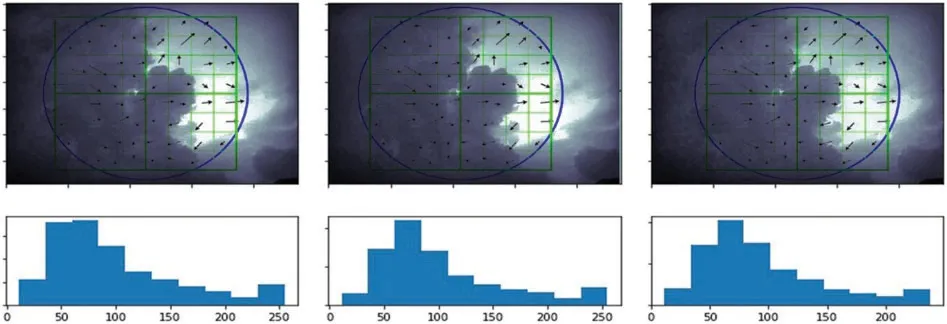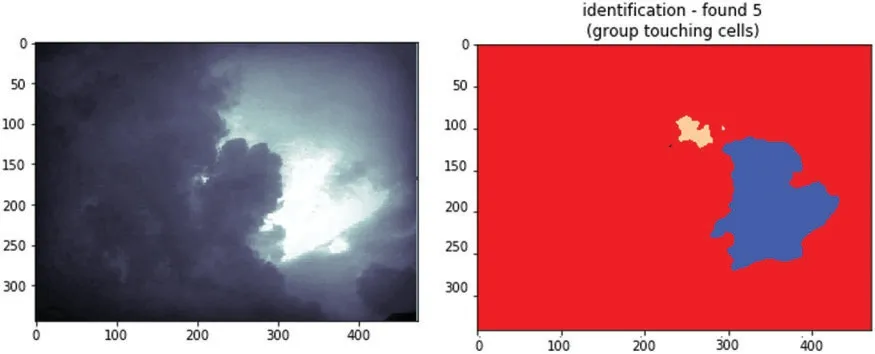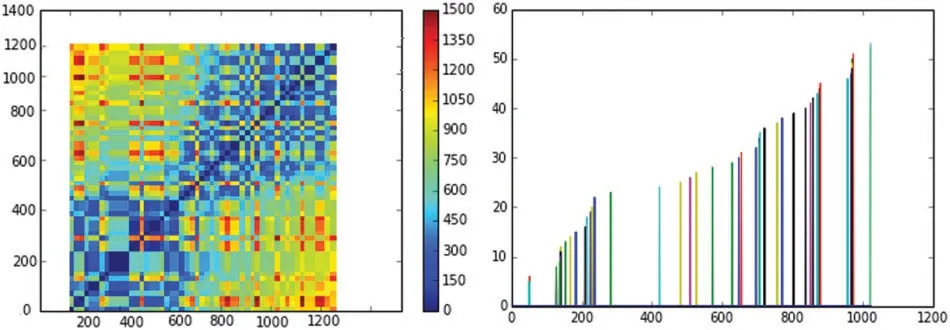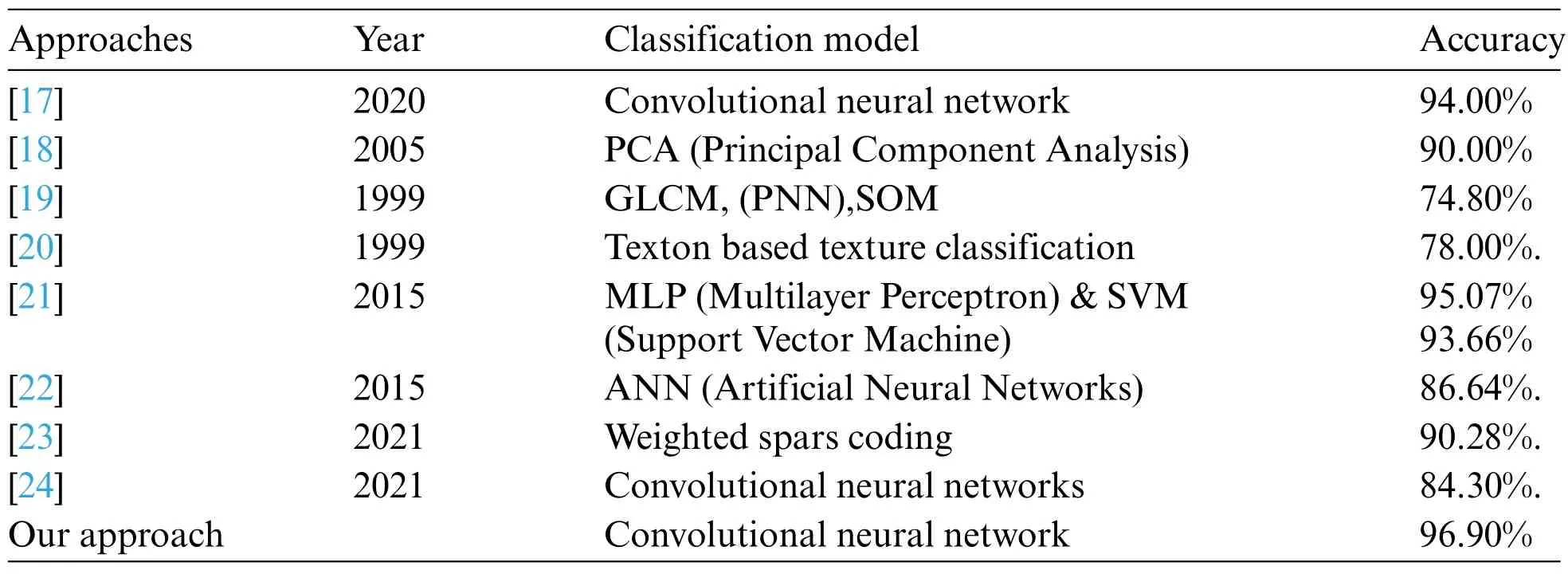Deep Learning Framework for Precipitation Prediction Using Cloud Images
Mirza Adnan Baig,Ghulam Ali Mallah and Noor Ahmed Shaikh
Shah Abdul Latif University,Khairpur,77150,Pakistan
Abstract: Precipitation prediction (PP) have become one of the significant research areas of deep learning (DL) and machine vision (MV) techniques are frequently used to predict the weather variables (WV).Since the climate change has left significant impact upon weather variables (WV) and continuously changes are observed in temperature,humidity,cloud patterns and other factors.Although cloud images contain sufficient information to predict the precipitation pattern but due to changes in climate,the complex cloud patterns and rapid shape changing behavior of clouds are difficult to consider for rainfall prediction.Prediction of rainfall would provide more meticulous assistance to the farmers to know about the weather conditions and to care their cash crops.This research proposes a framework to classify the dark cloud patterns(DCP)for prediction of precipitation.The framework consists upon three steps to classify the cloud images,first step tackles noise reduction operations,feature selection and preparation of datasets.Second step construct the decision model by using convolutional neural network(CNN)and third step presents the performance visualization by using confusion matrix,precision,recall and accuracy measures.This research contributes(1)real-world clouds datasets(2)method to prepare datasets(3)highest classification accuracy to predict estimated as 96.90%.
Keywords: Machine vision;SIFT features;dark cloud patterns;precipitation;agriculture
1 Introduction
Due to the climate change classification of dark cloud patterns(DCP)and precipitation prediction(PP)are considered one of significant research areas of deep learning.Machine vision(MV)techniques are widely used to explore the hindsight knowledge of the DCP and to present the unseen insight knowledge of weather conditions [1-4].Although cloud images contain sufficient information to predict the precipitation but due to changes in climate,the complex cloud patterns and rapid shape changing behavior of clouds are difficult to consider for rainfall prediction.Since the farmers are facing lots of difficulties to irrigate and pesticide their crops because raise in temperature and variation in precipitation patterns are dominant disturbing factors during the cultivation process[5-7].The farmers use to observe DCP and estimates about precipitation because timely information of rainfall would provide more assistance in decision making to irrigate or pesticide their cash crops[8].Traditionally,weather stations are being used to forecast the weather conditions around the globe and precipitation prediction is made by using online satellite cloud image analysis systems but due to the change in DCP,rainfall may not be recorded at particular coordinate of earth surface therefore machine learning framework is direly needed to construct a cloud classification model and to predict the precipitation patterns from local sky cloud images [9,10].Cloud images reveals significant key points in shape of water vapors,cloud droplets and evaporation process which defines the capability of cloud for precipitation [11-13];therefore we obtained key points by using scale-invariant feature transform SIFT features from cloud images and converted key points regions into tensor flow data to train and test the deep learning algorithm such as convolutional neural network.The SIFT algorithm is used to detect the sub-objects from images of clouds because it describes local features (LF) [14].Scale-invariant feature transform extracts key points (KP) of objects from the images to formulate the reference model and prepare repository of key points (KP) [15].We used SIFT framework to recognizes features of new image by estimating a comparison of features existing in historical data repository where feature vectors uses Euclidean distance(ED)to match object sets[15].The algorithm determines object features and its associated variables with best match strategy such as object locations,coordinates and etc.generalized Hough transformation (GHT) and hash table (HT) are used to perform rapid estimation of object identification(OI)[16].Several number of clusters are partitioned and at least three or more features of image meet the criteria of the subject of object than rest of features are considered as outlier and discarded accordingly.Object’s KP could be extracted by supplying parameters of feature description(FD)for any given image where FDs are derived from the training images and FDs provide assistance to identify significant sub-objects from the set of multiple objects within any image.The scale,noise and illumination constructs KP where high contrast regions(HCR) pertaining to any image could represent the object and its edges for pattern recognition.In SIFT characteristics of features along with associated positions for any image may remain unchanged therefore there are fair chances for higher estimation to recognize the patterns of various objects[18].In literature some of the nice approaches[17-24]are seen to construct the classification model but we obtained higher classification accuracy by performing a systematic approach to obtain key patterns(KP) of DCP;therefore,this paper offers a framework to classify the complex cloud patterns.The framework consists upon the three steps.In first step we preprocess the image which is also consisting upon several sub steps,in second step we construct the decision model by using convolutional neural network(CNN)and finally performance visualization by using confusion matrix,accuracy,precision and recall measures.This research contributes (1) real-world clouds datasets (2) method to prepare datasets(3)highest classification accuracy to predict PP problem estimated as 96.90%.
This paper is organized into several sections where section one presents introduction and section two describes literature review of related approaches;meanwhile section three defines the proposed methodology and section four describes the results of our proposed framework.Section five is dedicated to present the conclusion of this paper.
2 Literature Review
The approach of this paper falls into the domain of productive mining and deals with the classification problem of precipitation prediction by using dark cloud patterns.The approach proposes a data preparation method by extracting key points by using SIFT features and uses convolutional neural network (CNN) to predict the precipitation and non-precipitation conditions.Some related works are presented below.
A system[17]for classification of meteorological images was proposed to classify the cloud images.The machine learning technique convolutional neural network was used with combination of an improved FDM(Frame Difference Method).Clouds such as cumulus,cirrus and stratus features were extracted by using FDM.As per shown classification accuracy,there was 94%classification accuracy to predict the cumulus,cirrus and stratus class label attributes,whereas our proposed framework contributes a data preparation technique by using the SIFT features and classification accuracy with deep learning is measured as 96.90%.
A system [18]for classification of clouds was proposed and grey scale features were used and image analysis was done with PCA (Principal Component Analysis).Clear sky,mid-level clouds and high level clouds under the classification of cumulus,cirrus and stratus class label attributes were designed and estimated 90%classification accuracy was recorded,whereas the cloud sub-images selection algorithm would more accuracy to identify the region of interest (ROI) and classification accuracy could be increased.
A comparison [19]was proposed for classification of cloud data.The GLCM (gray-level cooccurrence matrix)and artificial neural networks based algorithms such as probability neural network(PNN)and unsupervised Kohonen self-organized feature map(SOM)were used.The best classification accuracy was measured as 74.8%with SOM was estimated,whereas the key points extracted as region of interest(ROI)with descriptive quantities in SIFT features could be more reliable to detect the sub-objects from cloud images.
A cloud image classification [20]was proposed by using texture features.Texton based texture classification method and classification accuracy was measured as 78%,whereas in deep learning rest of image vectors are loaded as trainable objects which consumes a very high amount of memory however sub-images of cloud image would reduce the training and testing time and classification accuracy of our framework was measured as 96.90%.
A system[21]for classification of cloud images was proposed and MLP(Multilayer Perceptron)&SVM (Support Vector Machine) were used to build the classification model.Estimated accuracy was measured as 95.07%and 93.66%were recorded respectively,whereas we use convolutional neural network (CNN) to build the classification model and accuracy of our framework was measured as 96.90%.
A system[22]was proposed to classify the cloud images Clouds such as cumulus,cirrus.The ANN(artificial neural networks) machine learning technique was used to build the classification model.The overall classification accuracy was reported as 86.64%.Whereas accuracy of our framework was measured as 96.90%.
A compression of deep learning techniques [23]for cloud classification were proposed where deep learning machine learning technique was used and representation of weighted spars coding are used.Cloud occlusion strategy consists up several occlusions where RIWSRC estimated with highest accuracy such as 90.28%,whereas data cleaning is an important part of data preparation because real world data needs to be cleaned with appropriate methods.The accuracy of our framework was measured as 96.90%.
A system[24]for cloud classification was proposed by using convolutional neural networks.The classification accuracy was measured as 84.30%,whereas accuracy of our framework was measured as 96.90%.Prediction of precipitation would provide more meticulous assistance to farmers and complex,heterogeneous cloud patterns could efficiently be classified by using convolutional neural network(CNN).
3 Methodology
This paper proposes a framework to predict the precipitation and non-precipitation clouds and contributes (1) real-world clouds datasets (2) method to prepare datasets (3) highest classification accuracy for participation prediction(PP)problem.The proposed approach falls into the productive domain of machine vision.We use SIFT based features to find the key points based sub-images and convert them into tensor flow data.We use convolutional neural network to construct the decision model.Precision,recall,confusion matrix are used for estimating the performance evaluation of proposed approach as shown in Fig.1.The proposed framework only deals with the clouds images.
a.Dataset

Figure 1:Deep learning framework for precipitation prediction using cloud images architecture
Cloud images captured from earth surface may become useful source for prediction the precipitation behaviors because dark cloud patterns(DCP)with variant grey appearance(VGA)are very hard to detect and classify.The videos of local precipitation patterns were downloaded from social medical applications such as Facebook.As use case we selected 10 videos for extracting the images from the frame sequences of video data.Around 400 dark cloud patterns(DCP)were selected for training and testing purposes.As per estimation each extracted image of cloud comprises over×100 magnification power whereas the size of each image was approximated with 4000×2500.
b.Key Points(KPs)and Feature Description(FD)
Let’s consider feature matching (FM) and feature indexing (FI) are descriptive vector data for recognizing the dark cloud patterns(DCP),where FI comprises over the functions of SIFT keys which has to identify the matching keys from the new image inputs.This feature selection technique is inspired from the experiment as conducted by Lowe in which he optimized the k-d tree algorithm,so called best-bin-first(BBF)search method.The method searches FM and FI from the images by estimating the nearest neighborhood set of pixels with highest probabilities under the limited computational time.The BBF algorithm keep the quantities of features in bins and feature space finds closest path distance to search the required patterns.KP with minimum KPs are search by mapping the minimal Euclidean distances from the descriptive vectors(DV)[25].
Therefore we transform the features by using Hugh transformation(HT)which is one of reliable method and can be used for classification of clusters by defining KPs.HT approximates clusters on the basis of ICM where analyzation of each feature can be interpreted by us FD vote strategy under higher probabilities.HT builds a hash table to match the various parameter of FD such as orientation,location and scaling where HT creates minimum 03 entries into the bin and finally bins size are sorted and decreased with respect to order orientations[26].Every image consists upon the SIFT KPs where a 2D locations interprets coordinates of particular pixel and second property describes the ICM i.e.,scale and orientation of pixel sets meanwhile the SIFT function matches all properties to vote particular object identification as per PKs training model.
Let’s consider coordinates of image represented byuxvwhere each KPs are placed inm1,m2,...mnmeanwhile thetxandtyrepresents the outputs of FDs.All k-clusters could be identified by matching the parameters of(x y)Tof KPs compared with quantities of(u v)Tto perform the affine transformation[27].

The constructed model(tx ty)Trepresents the transformation for the affine functions such as rotation,scale and stretch functions wherem1tom4vector spaces keeps the parameters as shown in Eqs.(1)and(2).

At least three matching bins are to be voted to qualify whereA≈bare directly associated with matrix represented as A vectors of u and v.however let’s assumeAT=ATbare the values where T could be divisible on bins as assigned to b.KPs and DF could be summarized by(AT A)-1ATand final output of SIFT is obtained by function as per Eq.(3).

Error detection can be done by removing the outliers where each image passes the parameters for feature model.In HT all the quantities are kept in bins which qualifies at least half of the value as per approximation [28].Let’s consider SIFT framework that creates KPs to detect the objects by convolving Gaussian filters at various scales and followed by the KPs are pointed with maximum and minim quantities of difference of Gaussian (DoG) at various scales as shown in Eq.(4) [29].DoG image could be represented asD (x,y,σ)
where imageDhasx,ylocation summarized asG (x,y,kσ)aid∂is the average of ICM at every pixel as shown as Fig.2.


Figure 2:Finding the Feature Matching(FM)and Feature Indexing(FI)vectors from cloud images
ICM at each pixels coordinatesI (x,y)can be computed by modelL (x,y,kσ)contains the convolutions of the DoG original image whereasis function to represent the Gaussian blur image approximated at various scales as shown in Eq.(5)[30].

All the averages ofkiσandkjσare loaded into the DF space where bins ofG (x,y,kσ)*L (x,y)function recorded as cortisone product of vector spaces and pixels are weighted by assigning the aggregated quantities as ICM variables.As per interpolation theorem nearby pixels are to be matched with KPs as FD to traverse the accurately most probable locations.First KPs are determined by estimating positions and scale of candidates KPs.Let us consider the functionD (x,y,σ)with KPs can be expressed as per Eq.(6).

Let’s consider a derivative dataset Dx=(x,y,∂)Tconsists upon KPs where strong candidates(SC) are to be selected and weak candidates (WC) are to be deleted.The matching function has to determine the coordinatesstrong KPs by initializing x vectors from zero points.If the compared KPs and DFs are matched with user fixed parameter 0.5 threshold with available dimensions the observation will be considered as selected as shown as Fig.3.The DFs designated asD (x)by taking first derivative of each pixel represented as,where foreground information could be computed for each object,however in SIFT we can discord the object information who does not qualify 0.03 threshold value of pixel contrast otherwise the detected object’s information has to be palace scale space coordinated represented byy+where y could be considered information of coordinates.
c.Visual Words(VW)


Figure 3:Key descriptive features and Difference of Gaussian(DoG)
As shown in Eq.(7);H are the significant KPs in the dataset D which consists upon the DF candidates whereaare significant larger set of objects whereasβare the smaller set of objects having less probability however a qualifying ratior=a/βis said to be sufficient for SIFT to reach at a decision[31].Traversing ofHis to be conducted from the vectors ofDxx+Dyywhere SCMDxx Dyy-D2xyare persisting with the ratio ofR=which+his to be estimated equal in terms of DFR quantities are the minimum tigers when become equal to KPs and DFs.However KPs are the candidate keys in dataset D extracted from the training or testing images by defining thevalues.At this stage the object detection uses images gradient directions by rotating to inversing at local level.Every pixel of image is smoothed by using Gaussian smooth functionL (x,y,σ)where mean values are filled at objects designated as L by partitioning the magnitude of every imagem (x,y)and difference of previously computed variablesθ (x,y)as shown in Eqs.(8),(9)and Fig.4.


Figure 4:Finding the Feature Matching(FM)and Feature Indexing(FI)process
Neighboring pixel quantities are estimated as per above equation on the basis of gradient of pixels each bin can be computed with 3 neighboring bins KPs and DFs are matched[32-35].

d.Tensor Flow Data Conversion
Let’s consider all explored scale objects in the format of invariant features as represented through SIFT operations.Considering Key points (KPs) and descriptive features (DFs) under the feature vectors of scale space structure(SSS)of the cloud objects.The transformation of all invariant objects contains sufficient content to be converted in tensor flow data for deep learning where color structure based features are recorded as per Eqs.(10)and(11).

A convolutional neural network(CNN)based model was constructed by using the pixel information of cloud images after the preprocessing steps as stated above section.we converted SIFT features into the tensor flowpklfile where tensor T data type is to be processed from various inputs layers,hidden layers,pooling and fully connected layers.The CNN gradient vectors loaded with the pixel information derived from the datasetDwhere all the object shapes and features were considered as gradient of(f)andgx+yx[36,37].The features coordinates such as(x,y)represents the shape on the bases ofzvariable where each pixel intensity is considerable amount of information which can be used to train and test the CNN architecture[38].
e.Input Layer of Proposed Model
We inputted a 3 dimensional cloud data as derived from the SIFT features.The input layer of convolutional neural network is comprising over three dimensions 28 × 28 × 1 which is 784 as represented into three dimensional matrix and reshaped into single column where m training observation will input 784,m size of inputs as shown in Fig.5.

Figure 5:Convolutional neural network architecture
f.Convolutional Layer
We extracted the features of cloud images by using the Convolutional layer,since each part of 28×28 matrix is loaded into a feature vector where each portion of cloud image connects to the receptive field because conv layer is responsible to perform the convolutional operation,mostly the result of convolutions is formed in shape of product and receptive field which s combination of local region in connection with region,the requirement could as same size of filter.The receptive fields are being visited by using a stride and ever pixel is examined and final outputs are supplied to ReLue activation which makes all negative quantities to zero.Then the outputs are supplied to pooling layer which performs reduction in spatial volumes as supplied to pooling layer as input.The layer deals with the variables among convolutional layer and fully connected layer.Since the without using max pool or layer there are fare chances for computationally expensive results because max performs reduction in spatial volumes into the input image.4×4 dimensional views could be observed with stride 2 under the surface of max pool layer.There is no parameter in pooling layer but it has two hyper parameters—Filter(F)and Stride(S).In general,if we have input dimension W1×H1×D1,then

where W2,H2 and D2 are the width,height and depth of output as per Eq.(12).
g.Fully Connected and Output Layers
The variables of dot product are assigned to fully connected layer and it also hold the softmax layer where fully connected layer has to produce classification results upon the output layer.The fully connected layer not only connects all the neurons but it tackles weights and biases as well.Fully connected layer involves weights,biases,and neurons.
h.Performance
The performance of our proposed framework have been investigated by using the confusion matrix.The matrix holds the quantities in terms of true positive and true negative number of observation whereas precision measure holds the number of true positive observations and determines that how the system has understood training data.The recall measure shows that what is the capability of constructed model to identify the new instances.

We approximated accuracy as Eq.(13) whereas precision as per Eq.(14) and recall measure as Eq.(15).
4 Results and Discussion
This paper offers a framework for prediction of precipitation and classifies cloud objects using convolutional neural network.Cloud image data was extracted from social media applications in video format and converted into images by considering the significance of video frames.As use case we selected 100 videos for extracting the images from the frame sequences of video data.Around 2000 cloud images were selected for training and testing purposes.In data preparation layer our approach performs noise reduction by using SIFT features and convert them into tensor flow data where feature matching(FM)and feature indexing(FI)are descriptive vectors are trained to recognize the patterns of cloud images.As per Figs.3 and 4 the method searches FM and FI from the images by estimating the nearest neighborhood set of pixels with highest probabilities under the limited computational time.The BBF algorithm keep the quantities of features in bins and feature space finds closest path distance to search the required patterns.KP with minimum KPs are search by mapping the minimal Euclidean distances from the descriptive vectors (DV).SIFT framework that creates KPs to detect the objects by convolving Gaussian filters at various scales and followed by the KPs are pointed with maximum and minim quantities of difference of Gaussian(DoG)at various scales.DoG image could be represented asD (x,y,σ)where imageDhasx,ylocation summarized asG (x,y,kσ)aid∂is the average of ICM at every pixel as shown in Fig.2.After acquiring the key features and pattern detection,the tensor flow features of objects were acquired to train the CNN classifier to find out deepest knowledge of cloud data.The precipitation=yes and precipitation=no class label attribute were assigned by the nature of pictures.Confusion matrix results show that precipitation=yes class classified 612 observation and misclassified 37 instances whereas precision was recorded as 94.29%and recall measure 94.73%was estimated as shown in Tabs.1 and 2.In Class label attribute precipitation=no class classified 1611 observations and misclassified 34 observations,whereas precision was recorded as 97.93%and recall measure was estimated as 97.75%,meanwhile overall classification estimation was measured as 96.90%as shown in Tab.3.

Table 1:Precipitation and non-precipitation:Confusion matrix

Table 2:Performance of proposed system

Table 3:Comparative analysis
5 Conclusion
Weather prediction is an important problem for every business but particularly precipitation prediction(PP)would provide more assistance to farmers to grow crops in their fields;Deep learning techniques are frequently used to predict the weather variables (WV).We use cloud image data captured from the frames of videos pertaining the information of precipitation from social medical applications such as Facebook.As use case we selected 100 videos for extracting the images from the frame sequences of video data.Around 2000 cloud images were selected for training and testing purposes.However,dark cloud patterns(DCP)with variant grey appearance(VGA)are very hard to detect and to consider for training of machine learning algorithms.Identification clouds would provide more meticulous assistance to the common people to know about the weather conditions at their region.This research proposes a framework to classify the dark cloud patterns(DCP)for precipitation prediction(PP).The framework consists upon three steps,first step tackles noise reduction operations,feature selection and preparation of datasets.Second steps construct the decision model and third step presents the results visualization by using confusion matrix,precision,recall and accuracy measures.Confusion matrix results show that precipitation=yes class classified 612 observation and misclassified 37 instances whereas precision was recorded as 94.29%and recall measure 94.73%was estimated.In Class label attribute precipitation=no class classified 1611 observations and misclassified 34 observations,whereas precision was recorded as 97.93%and recall measure was estimated as 97.75%,meanwhile overall classification estimation was measured as 96.90%.This research contributes (1)real-world clouds datasets(2)method to prepare datasets(3)highest classification accuracy to predict PP problem measured as 96.90%.
Acknowledgement:We shall remain thankful to the Department of Computer Science,Shah Abdul Latif University for providing a nice environment to conduct the research.
Funding Statement:The authors received no specific funding for this study.
Conflicts of Interest:The authors declare that they have no conflicts of interest to report regarding the present study.
 Computers Materials&Continua2022年8期
Computers Materials&Continua2022年8期
- Computers Materials&Continua的其它文章
- EACR-LEACH:Energy-Aware Cluster-based Routing Protocol for WSN Based IoT
- Medical Image Analysis Using Deep Learning and Distribution Pattern Matching Algorithm
- Fuzzy MCDM Model for Selection of Infectious Waste Management Contractors
- An Efficient Scheme for Data Pattern Matching in IoT Networks
- Feedline Separation for Independent Control of Simultaneously Different Tx/Rx Radiation Patterns
- Deep-piRNA:Bi-Layered Prediction Model for PIWI-Interacting RNA Using Discriminative Features
